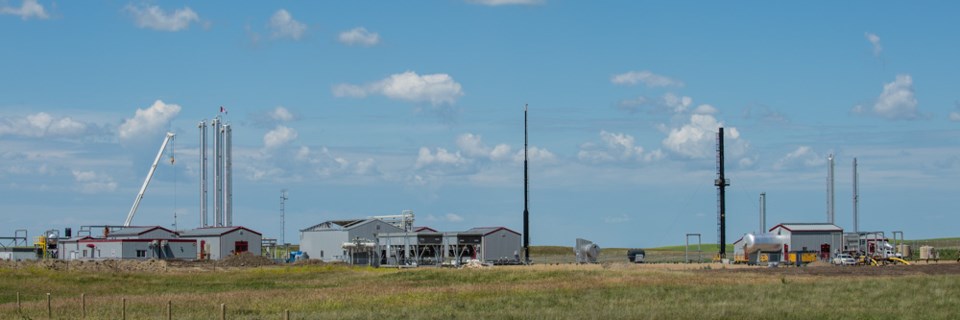Regina– Ed Dancsok has a new job within the Ministry of Economy. Previously assistant deputy minister for petroleum and natural gas, he’s still in an ADM job, but with a different role.
“The model has changed here at the ministry, so to speak. They’ve split our regulatory role and our development role into two groups.”
Doug McKnight has taken over the regulatory side of things.
“My role here is as chief strategic lead, making sure investment continues in Saskatchewan and that we’re building the best business climate that we can to make that happen. It’s tough for me to do if I’m still a regulator.”
“I’m an ADM, but it’s more of a matrix-type situation. I don’t have staff that report to me, but I can go across divisions, wherever I need, to pick out the key people I need to make things happen. If we have an issue with SaskPower or SaskEnergy, or an RM, or a company that’s come to the province and is doing a project and needs assistance and guidance in getting things done, I’m here to get things done.”
One issue that has come up with Pipeline News’ discussions with industry players is the need for more natural gas infrastructure, particularly now with the full implementation of the province’s S-10 directives on the conservation of natural gas and reduction of flaring.
With regards to the development of natural gas infrastructure, Dancsok said, “The need for more infrastructure to support this is very real. The goals of S-10 cannot be achieved until we get more infrastructure put in place.
“I think with the announced gas plant expansions, we likely have enough gas plant capacity to take all the gas, but we have to get it there.
“It’s an infrastructure deficit; I guess you could call it.”
The deficit is on the gas collection side, as opposed to transmission, according to Dancsok.
“There’s a lot of work we need to do with SaskEnergy and the producers in identifying the areas where it makes sense to get infrastructure built. That certainly now is part of my job.”
There’s an opportunity for SaskEnergy to build collection systems, he explained.
In 2003 Saskatchewan had 2,318 natural gas wells drilled, a peak for natural gas drilling. By 2007, before prices declined dramatically for gas, we drilled 1,154 wells. In 2014, that number was about 10, according to information the ministry provided Pipeline News in May this year. Targetted natural gas drilling occurred on the western side of the province, whereas associated gas; natural gas produced as part of oil production; has risen a great deal in the east. Saskatchewan is now a net gas importer.
Will new volumes in the east make up for the decline of production in the west?
Dancsok replied, “We have seen, with the expansion of the oilfields, a lot of associated gas. Associated gas now out-produced non-associated gas, to the extent where it has reversed the decline in the overall provincial natural gas product.
“That is certainly a bright spot.
“We peaked in natural gas production about 2006. Will we get back to that point? I don’t know. But we have reversed that trend, over the past couple years. If we can full invoke S-10, that will add to the mix. But to get back to those peak days, it might be a bit of a stretch.”
Due to natural decline curves, dry natural gas wells for non-associated gas need to be supplemented with new drilling to maintain production. As drilling has declined to next to nothing, natural declines are taking its course.
In 2006 Saskatchewan peaked at approximately 330 billion cubic feet per year. We’re now just under 210 to 220 billion cubic feet per year, having just turned that decline around. Non-associated gas continues to decline, but associated gas has turned around the whole picture and gas production overall is on the rise. Production had bottomed out at just under 200 billion cubic feet per year.
The Viking play near Kindersley has a “good portion of associated gas, and a growing amount in the southeast,” Dancsok said.
Crescent Point completed an expansion in 2014 of its Leitchville plant, near Shaunavon. Teine Energy also had an upgrade project for Elrose.
The amount of investment into natural gas collection going on in Saskatchewan is currently in excess of hundreds of millions of dollars. Does Dancsok think this would have occurred without the government bringing in gas conservation regulations?
“That’s a good question. I think a certain amount of regulatory oversight does drive investment. Prior to things like S-10, and some of the other initiatives we’ve been doing, companies were spending their compliance dollars elsewhere.
“By us flexing our regulatory muscles, we’re making some of those compliance investment dollars happen on this side of the border now.”
Dancsok emphasized that S-10 was not only about the environmental benefits, but also the resource conservation benefits and the economic benefit.
“It’s generating a minor influx of investment in Saskatchewan by the building of this infrastructure. Every incremental build of infrastructure improves the economics for the rest of the system,” Dancsok said.
Capturing more gas means more royalties, but the amount is a proverbial drop in the bucket.
The total amount of gas royalties for the entire province was projected to be $19.1 million in the 2015 provincial budget. Thus, the increased royalties collected from the new gas plants will be minimal, at best.
Dancsok noted that the royalty rate on associated gas is lower than on non-associated gas.
“If gas (prices) were in their heyday, we wouldn’t be talking about this at all. it would be looked after. That’s what we’ve got to try to do is make sure it is economic for the industry. If it becomes economic, we don’t have to bring down hammers anymore, the compliance looks after itself.




